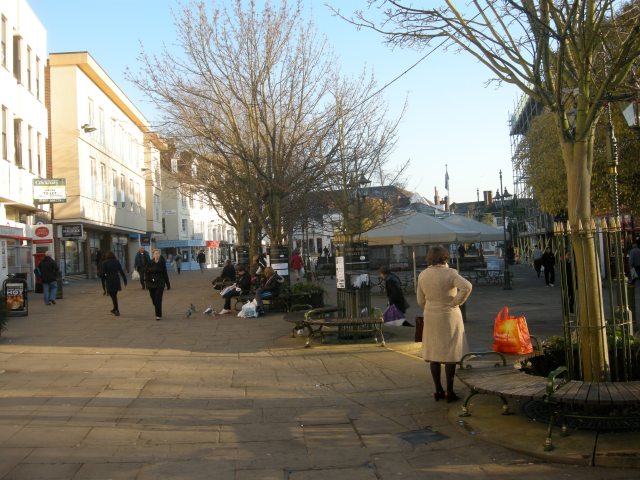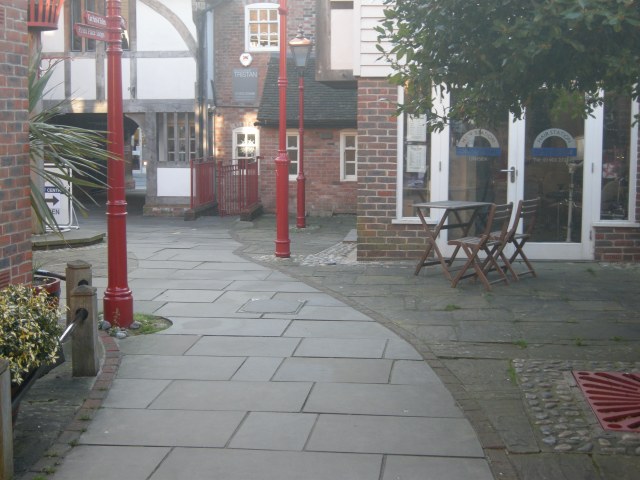More on the ongoing saga of East Street in Horsham.
I wrote back in October about opposition to the pedestrianisation of this increasingly popular and thriving street in the town centre during the main hours of the day. That article is a useful summary of the history of the street over the last couple of years, and also about the main issues – principally that a handful of people still want to continue driving and parking on the street, at all times.
In December another article appeared in the local paper setting out the opinions of one of these opponents.
A disabled man with severe mobility issues feels the council has effectively segregated a Horsham street by forcing through pedestrianisation.
When the barriers are up at the end of East Street, disabled drivers are unable to access the parking bay outside Ask specifically designated for blue-badge holders, such as Mr Owles, who takes 26 tablets a day, including 18 painkillers, and cannot walk long distances.
“What they have done is segregated people out of East Street,” he said. “They’re just riding roughshod over everybody, with no consideration for the disabled.”
Just as with the article that appeared in the paper in October, the opponent of pedestrianisation is claiming that it is unfair to disabled people to prevent them parking in the bays in East Street (and in Market Square, which is only accessible from East Street). I won’t re-hash the reasons why I think this is incorrect; refer to my previous piece if you so wish.
What I would say here is that there are many, many streets and areas of Horsham that are not accessible by car. People who are disabled – and quite clearly their needs should be taken very seriously indeed – still manage to access these shops, by means other than the private motor vehicle. Here are some of those areas.
The large Swan Walk shopping centre. Around 40 shops here, none of which can be parked outside.
A section of the pedestrianised Bishopric. You can’t park here.
Springfield Road. Despite the security van, it’s not legal to park here either.
The north end of Worthing Road. Pedestrianised.
The Forum, with access to Beales Department store, TK Maxx, and a coffee shop. No driving or parking here.
West Street – probably Horsham’s busiest street. Pedestrianised.
Middle Street. No parking here either.
A handful of shops on Medwin Walk. No parking.
The western section of the Carfax. Pedestrianised.
Pirie’s Place. A dozen or so shops here, including a supermarket. Again, no parking.
And finally, East Street and Market Square – the areas that are now pedestrianised during the day, a pedestrianisation which is being opposed.
 As you can see, there are huge areas of the town that are already completely inaccessible by motor vehicle. Indeed, the vast majority of the town’s shops are in fully pedestrianised areas.
As you can see, there are huge areas of the town that are already completely inaccessible by motor vehicle. Indeed, the vast majority of the town’s shops are in fully pedestrianised areas.
Disabled people are not ‘banned’ or ‘segregated’ from these shops. They simply have to access them by means other than the private motor car. While cars are plainly a very important way of allowing disabled people to make longer trips into town, they cannot be the sole mode of transport for disabled people. If it was, we could have to completely redesign almost every aspect of our streets, our buildings, and our infrastructure to make them accessible by motor vehicle, which is obviously completely absurd.
Great steps have been made in recent years towards making public transport and public buildings much more accessible for disabled people. Train stations increasingly have step-free access. Buses and trains are now accessible in wheelchairs – something that even 20 years ago was quite rare, at least where I live. These are obviously necessary improvements. However, these changes have been made to allow wheelchair access, and not private car access. You can’t drive into public buildings. You can’t drive through airports. These parts of journeys have to be made by other means.
I don’t think it would be reasonable for the people objecting to the part-pedestrianisation of East Street to claim they have been ‘banned’ from airports, or from train stations, or from office blocks, or ‘segregated’ from large department stores, simply because they can’t drive into them or around them. The private car is an unwieldy way for disabled people to convey themselves in these kinds of spaces, and we quite rightly expect them to use smaller motorised vehicles, like mobility scooters, or powered wheelchairs. Precisely the same logic applies (or should apply) on pedestrianised streets.
David Moore of the Horsham Society has made much the same argument I have been making for some time about East Street in a comment piece in the latest West Sussex County Times – namely that parking is available nearby, and that other more ‘inaccessible’ (by car, of course) streets in Horsham are not subject to these kinds of complaints.
The pedestrianisation of East Street between 10.30 and 16.30 has been an unmitigated success. It’s been wonderful to be able to walk down the street without being hooted at by a lorry or a car. It’s been terrific not to have to inhale the exhaust fumes from passing or parked vehicles. The vast majority of the people of Horsham continue to support the exclusion of vehicles from the street.
[Obviously] … we have to consider access for people with disabilities. Fortunately, there are significant numbers of parking spaces for Blue Badge holders in the vicinity of East Street, such as in the Denne Road and Piries Place car parks. Parking is also usually available on single or double yellow lines for up to three hours and this can be seen, for example, in the regular use of the Causeway during the day by Blue Badge holders.
So it’s difficult to understand why there should be a need for parking by Blue Badge holders in a relatively short street such as East Street when there’s no such facility available to them in the pedestrianised and much longer West Street.
I am pleased to see that the council are also resistant to calls to reopen the street to motor vehicles. They can see what a difference it has made to businesses on the street, and to the experience of pedestrians.
The East Street matter is now going to a public inquiry, costing the council some £25,000. I am sad that it is taking this much money to settle what is quite obviously a bogus issue; the only hope is that the inquiry will finally put an end to these complaints.
UPDATE – I forgot to include this wonderful video from Mark Wagenbuur, showing how Dutch towns and cities are highly accessible for those with disabilities, without using private motor cars. (His post on the subject is here).






You beat me to it with your update – I love that video. 🙂
Of course you do realise that by listing other pedestrianised locations you’ll get the argument that there are already too many “segregated” areas; how will the disabled ever get a quality Italian meal at reasonable prices?
I think people need to broaden their thinking on these matters. I would have thought that disabled folks would have embraced the removal of motor vehicles as a way of giving themselves a safer, slower environment to move through using their mobility vehicles.
I note the article describes the disabled gentleman as “furious” – West Sussex County Times’ words, not his own, judging by the quotes they carry – which leads me to reflect on how “fury” and “disgust” seem to run through well-heeled semi-rural communities like Horsham or my own stamping ground, Haslemere. Of course Tunbridge Wells is celebrated as the home of “disgusted” of TV programme complaining folklore. We had, according to our local rag, an outbreak of “fury” over the temporary suspension of on-street parking bays before Christmas, as a result of the need to keep a clearway for emergency services vehicles when another local road was partially closed by construction work. I was listening to an interesting discussion on Radio 4 on Saturday morning, in which some psychologist was explaining that disgust is an emotion primarily expressed by people of conservative disposition, which in turn normally implies affluent.
We don’t have much – actually, any – pedestrianised streets in Haslemere, more’s the pity. We have to endure traffic passing constantly through the High Street, which doubles as the A286. We certainly haven’t suffered any loss of parking spaces or car access for that reason, and being a compact sort of place all the off-street parking is very close to all the shops, (but is of course charged for), but we still get quite a lot of fury when a few (free) on-streeet parking spaces disappear. The nearest comparable is the reaction to the county council’s decision to install a zebra crossing, the knock-on consequences of which are that a bus stop has to move, and the space it has to move to happens to be a layby which can accommodate three cars on short stays, but which will now be a Bus Clearway. Local retailers seem to think this means the sky will fall in, and after all no-one has actually died there yet have they? Other residents prefer not to wait for a death to prove the point.
Of course, Christmas, being a time of goodwill to all men, brings out all the lame comparisons with places that opened their car parks up fee-free to Christmas shoppers, despite at least two such towns’ scepticism – Newport in S Wales’ chamber of trade saying that free parking was a “plaster on a broken artery”, and Wokingham’s chamber of commerce observing that free parking is an irrelevance, what matters is that the town has shops people want to visit, just look at Reading where relatively pricey car parks have cars queuing round the block.
You wonder who put this gentleman up to it to make an issue of this. I always think there is some other agenda at work here.
The way that journalism seems to work, you never have any clue of exactly how many people agree with the stance portrayed. A journalist goes out with an idea of opposition, finds someone who does indeed think that way, and then writes about seething elderly foaming at the mouth. No clues about the actual facts of opposition. But it does set the tone.
Alas, I have no idea how to change this….
What an idiotic argument. You could just as well claim that parking on pavements is segregation against people in wheelchairs since it often forces them to go around the car onto the road.
Wait, needs moar sensationalism, its anti-family too, prams and pushchairs, yeah.
You won’t hear that from the motoring lobby.